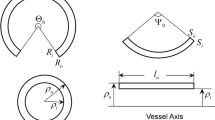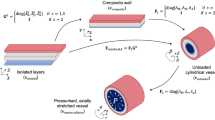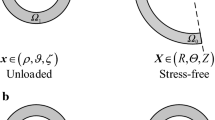Abstract
The objective is to know the stress distributions in the arterial walls under residual stresses based on two-layer model. Human common carotid arteries were analysed to show stress distributions at physiological and supraphysiological intraluminal pressures. The analyses for the loaded states were performed with stretch ratios with reference to a Riemannian stress-free configuration which is a 3D non-Euclidean manifold due to the nonzero Riemann curvature tensor. The experimental data obtained by other literature were used for the common carotid arteries to analyse the stretch and stress distributions in the arterial wall although kinematics is different from the literature. The stretches and stresses were calculated for the unloaded state, i.e. the residual stretches and stresses. And those at the axial stretch ratio 1.1 with reference to the unloaded state were calculated at the intraluminal pressures 16, 50, and 100 kPa. The stresses increased from the inner surface to the outer surface at all pressures analysed. These results suggest that in the human arteries the mechanical loads are mainly supported with the adventitia even though the media and intima play an important role to control of physiological functions.








Similar content being viewed by others
References
Chuong CJ, Fung YC (1983) Three-dimensional stress distribution in arteries. J Biomech Eng 105:268–274. https://doi.org/10.1016/0021-9290(84)90142-8
Chuong CJ, Fung YC (1986) On residual stresses in arteries. J Biomech Eng 108:189–192. https://doi.org/10.1115/1.3138600
Fung YC, Liu SQ (1989) Change of residual strains in arteries due to hypertrophy caused by aortic constriction. Circ Res 65:1340–1349. https://doi.org/10.1161/01.RES.65.5.1340
Holzapfel GA, Gasser TC (2007) Computational stress-deformation analysis of arterial walls including high-pressure response. Int J Cardiol 116:78–85. https://doi.org/10.1016/j.ijcard.2006.03.033
Holzapfel GA, Gasser TC, Ogden RW (2000) A new constitutive framework for arterial wall mechanics and a comparative study of material models. J Elast 61:1–48. https://doi.org/10.1023/A:1010835316564ArticleGoogleScholar
Holzapfel GA, Sommer G, Gasser CT, Regitnig P (2005) Determination of layer-specific mechanical properties of human coronary arteries with nonatherosclerotic intimal thickening and related constitutive modeling. Am J Physiol Heart Circ Physiol 289:H2048–H2058. https://doi.org/10.1152/ajpheart.00934.2004
Holzapfel GA, Sommer G, Auer M, Regitnig P, Ogden RW (2007) Layer-specific 3D residual deformation of human aortas with non-atherosclerotic intimal thickening. Ann Biomed Eng 35:530–545. https://doi.org/10.1007/s10439-006-9252-z
Klarbring A, Olsson T, Stålhand J (2007) Theory of residual stresses with application to an arterial geometry. Arch Mech 59:341–364
Lu X, Pandit A, Kassab GS (2004) Biaxial incremental homeostatic elastic moduli of coronary artery: tow-layer model. Am J Physiol Heart Circ Physiol 287:H1663–H1669. https://doi.org/10.1152/ajpheart.00226.2004
Patel DJ, Fry DL, Janicki JS (1969) The elastic symmetry of arterial segments in dogs. Cir Res 24:1–8. https://doi.org/10.1161/01.RES.24.1.1
Rachev A, Stergiopulos N, Meister J-J (1996) Theoretical study of dynamics of arterial wall remodeling in response to changes in blood pressure. J Biomech 29:635–642. https://doi.org/10.1016/0021-9290(95)00108-5
Sokolnikoff IS (1964) Tensor analysis: Theory and applications to geometry and mechanics of continua, 2nd edn. Wiley, New York
Sommer G, Holzapfel GA (2012) 3D constitutive modeling of the biaxial mechanical response of intact and layer-dissected human arteries. J Mech Behav Biomed Mater 5:116–128. https://doi.org/10.1016/j.jmbbm.2011.08.013
Sommer G, Regitnig P, Kӧltringer L, Holzapfel GA (2010) Biaxial mechanical properties of intact and layer-dissected human carotid arteries at physiological and supraphysiological loadings. Am J Physiol Heart Circ Physiol 298:H898–H912. https://doi.org/10.1152/ajpheart.00378.2009
Takamizawa K, Hayashi K (1987) Strain energy density function and uniform strain hypothesis for arterial mechanics. J Biomech 20:7–17. https://doi.org/10.1016/0021-9290(87)90262-4
Takamizawa K, Nakayama Y (2013a) Non-Euclidean stress-free configuration of arteries accounting for curl of axial strips sectioned from vessels. J Biomech Eng 135:114505. https://doi.org/10.1115/1.4025328
Takamizawa K, Nakayama Y (2013b) Stress distribution in a bilayer elastic model of coronary artery. J Appl Mech 80:041006. https://doi.org/10.1115/1.4007863
Truesdell C, Noll W (1965) The non-linear field theories of mechanics. In: Flügge S (ed) Encyclopedia of physics, vol III/3, Springer-Verlag, Berlin-Heidelberg-New York. https://doi.org/10.1007/978-3-642-46015-9_1
Vaishnav RN, Vossoughi J (1987) Residual stress and strain in aortic segments. J Biomech 20:235–239. https://doi.org/10.1016/0021-9290(87)9290-9
von Maltzahn WW, Warriyar RG, Keitzer WF (1984) Experimental measurements of elastic properties of media and adventitia of bovine carotid arteries. J Biomech 17:839–847. https://doi.org/10.1016/0021-9290(84)90142-8
Vossoughi J (1992) Longitudinal residual strains in arteries. In: Proceedings of the 11th southern biomedical engineering conference, Memphis, TN, pp 17–19
Wang R, Gleason RL (2010) A mechanical analysis of conduit arteries accounting for longitudinal residual strains. Ann Biomed Eng 38:1377–1387. https://doi.org/10.1007/s10439-010-9916-6
Wang R, Gleason RL (2014) Residual shear deformations in the coronary artery. J Biomech Eng 136:061004. https://doi.org/10.1115/1.4027331
Wang C, Garcia M, Lu X, Lanir Y, Kassab GS (2006) Three-dimensional mechanical properties of porcine coronary arteries: a validated two-layer model. Am J Physiol Heart Circ Physiol 291:H1200–H1209. https://doi.org/10.1152/ajpheart.01323.2005
Yavari A (2010) A geometric theory of growth mechanics. J Nonlinear Sci 20:781–830. https://doi.org/10.1007/s00332-010-9073-y
Author information
Authors and Affiliations
Corresponding author
Ethics declarations
Conflict of interest
The author declares that he has no conflict of interest.
Additional information
Publisher's Note
Springer Nature remains neutral with regard to jurisdictional claims in published maps and institutional affiliations.
Appendix 1
Appendix 1
If the Riemannian stress-free configuration is non-Euclidean, the Riemann curvature tensor is not zero and the stress-free configuration cannot be embedded in 3D Euclidean space. The covariant components of Riemann curvature tensor are defined as follows (Sokolnikoff 1964):
where a, b, c, d, e, f are variable sub- and super-scripts taking values of 1, 2, 3, and \(\eta^{{{\text{ef}}}}\) denote the reciprocal components of the metric tensor and \(\Gamma_{{{\text{ead}}}}\) the Christoffel symbols of the first kind, respectively. We omit the subscript of X which denotes adventitia or media and take \(\xi^{1} = \vartheta\), \(\xi^{2} = \zeta\), \(\xi^{3} = \rho\).
In general, the number of distinct components of Riemann curvature tensor that may not vanish is six for 3D manifold, because a n-dimensional Riemannian manifold has \(n^{2} (n^{2} - 1)/12\) of distinct components (Sokolnikoff 1964).
The Christoffel symbols of the first kind (Sokolnikoff 1964) of the Riemannian stress-free configuration are:
where the components of the metric tensor in the present study are as follows (Eq. 7):
The Christoffel symbols of the first kind of 3D manifold in the present study are as follows:
-
(1)
$$a = b:$$
-
(i)
$$a = c:\;\Gamma_{{{\text{caa}}}} = \frac{1}{2}\frac{{\partial \eta_{{{\text{aa}}}} }}{{\partial \xi^{{\text{a}}} }}\;\;\left( {{\text{not sum with}}\;a} \right)$$
Nonvanishing case:
-
(ii)
$$a \ne c:\;\Gamma_{{{\text{caa}}}} = - \frac{1}{2}\frac{{\partial \eta_{{{\text{aa}}}} }}{{\partial \xi^{{\text{c}}} }}\;\;\;\left( {{\text{not sum with}}\;a} \right)$$
Nonvanishing case:
-
(2)
$$a \ne b:$$
-
(i)
$$a = c:\;\Gamma_{{{\text{cab}}}} = \frac{1}{2}\frac{{\partial \eta_{{{\text{aa}}}} }}{{\partial \xi^{{\text{b}}} }}\;\;\;\left( {{\text{not sum with}}\,a} \right)$$
Nonvanishing case:
-
(ii)
$$ii)\;b = c:\;\Gamma_{{{\text{cab}}}} = \frac{1}{2}\frac{{\partial \eta_{{{\text{bb}}}} }}{{\partial \xi^{{\text{a}}} }}\;\;\;\left( {{\text{not sum with}}\;b} \right)$$
Nonvanishing case:
Therefore, the nonvanishing components of the Christoffel symbols of the first kind are as follows:
The independent covariant components of Riemann curvature tensor in 3D Riemannian manifold are \(R_{\vartheta \zeta \vartheta \zeta }\), \(R_{\vartheta \rho \vartheta \rho }\), \(R_{\zeta \rho \zeta \rho }\), \(R_{\vartheta \zeta \vartheta \rho }\), \(R_{\zeta \vartheta \zeta \rho }\), \(R_{\rho \vartheta \rho \zeta }\):
By the similar calculations we can obtain the following results:
Rights and permissions
About this article
Cite this article
Takamizawa, K. Stretch and stress distributions in the human artery based on two-layer model considering residual stresses. Biomech Model Mechanobiol 21, 135–146 (2022). https://doi.org/10.1007/s10237-021-01523-8
Received:
Accepted:
Published:
Issue Date:
DOI: https://doi.org/10.1007/s10237-021-01523-8




